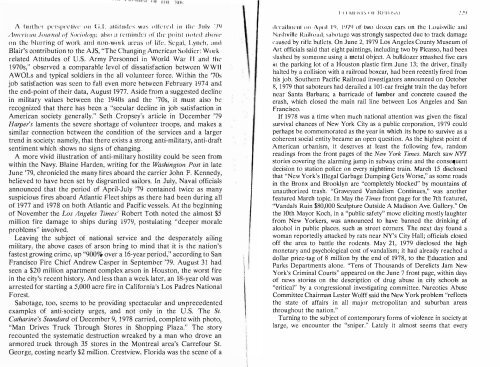CONTENTS - ouroboros ponderosa
CONTENTS - ouroboros ponderosa
CONTENTS - ouroboros ponderosa
You also want an ePaper? Increase the reach of your titles
YUMPU automatically turns print PDFs into web optimized ePapers that Google loves.
i\ flllllH"I" 1H"ISIHTlivl' lHI (i,1. ;tlliltltks W;IS oli"l-r ni ill jill' .f lll.v ,,/1)<br />
/1"/{'rlnlll .Iounwl of Sociology. also tI rl'milHkr nr lI1e pc Jill! outed ;t!l( lV{'<br />
on the hlurring of work and non-work areas of life. Segal, Lynch , alld<br />
Blair's contribution to the AJS, "The Changing Amcrican Soklicr: Work<br />
related Attitudes of U.S. Army Personnel in World War II and the<br />
1970s," observed a comparable level of dissatisfaction between WWII<br />
A WOLs and typical soldiers in the all volunteer force. Within the '70s<br />
job satisfaction was seen to fall even more between February 1974 and<br />
the cnd-point of their data, August 1977. Aside from a suggested decline<br />
in military values between the 1940s and the '70s, it must also be<br />
recognized that there has been a "secular decline in job satisfaction in<br />
American soeiety generally." Seth Cropsey's article in December '79<br />
Harper's laments the severe shortage of volunteer troops, and makes a<br />
similar connection bctween the condHion of the services and a larger<br />
trend in society: namely, that there exists a strong anti-military, anti-draft<br />
sentiment which shows no signs of changing.<br />
A more vivid illustration of anti-military hostility could be seen from<br />
within the Navy. Blaine Harden, writing for the Washington Post in late<br />
June '79, chronicled the many fires aboard the carrier John F. Kennedy,<br />
believed to have been set by disgruntled sailors. [n July, Naval officials<br />
announced that the period of April-July '79 contained twice as many<br />
suspicious fires aboard Atlantic Fleet ships as there had been during all<br />
o( 1977 and 1978 on both Atlantic and Pacific vessels. At th!! beginning<br />
of November th!! Los Angeles 1imes' Robert Toth noted the almost $5<br />
million fire damage to ships during 1979, postulating "de!!p!!r morale<br />
problems" involved.<br />
Leaving the subject of national service and th!! desperately ailing<br />
military, the above cases of arson bring to mind that it is the nation's<br />
fastest growing crime, up "900% over a 16-year period," according to San<br />
Francisco Fire Chief Andrew Casper in September '79. August 31 had<br />
seen a $20 million apartment complex arson in Houston, the worst fire<br />
in the city's recent history. And less than a wc!!k later, an IS-year old was<br />
arrested for starting a 5,000 acre fire in California's Los Padres National<br />
Forest.<br />
Sabotage, too, seems to be providing spectacular and unprecedented<br />
e.xamplcs of anti-society urges, and not only in the U.S. The St.<br />
Catharine's Standard of December 9, 1978 carried, complete with photo,<br />
"Man Drives Truck Through Stores in Shopping Plaza." The story<br />
recounted the syst!!matic destruction wreaked by a man who drove an<br />
armored truck through 35 stores in the Montreal area's Carre four St.<br />
George, costing nearly $2 million. Crestview, Florida was the scene of a<br />
,<br />
,<br />
\<br />
,<br />
,<br />
•<br />
,<br />
,<br />
I<br />
I<br />
,<br />
,<br />
1·1 1 l\·II·NT (lI· 1':'1:1-1 1:-',\ 1 ,) .HI<br />
derailml'nt OIJ t\1" il II), Itn() of two dOl.en cars on the Louisville and<br />
Nashville Rail'",,,t; sabotage was strongly suspected due to track damage<br />
,"aused by rifle butlets. On June 2, 1979 Los Angeles County Museum of<br />
Art officials said that eight paintings, including two by Picasso, had been<br />
slashed hy someone using a metal object. A bulldozer smashed five cars<br />
ill the parking lot of a Houston plastic firm June 13; the driver, finally<br />
halted by a collision with a railroad boxcar, had been recently fired trom<br />
his job. Southern Pacific Railroad investigators announced on Octo her<br />
8, 1979 that saboteurs had derailed a 100 'car freight train the day before<br />
ncar Santa Barbara; a barricade of lumber and concrete caused the<br />
crash, which closed the main rail line between Los Angeles and San<br />
Francisco.<br />
If 1978 was a time when much national attention was given the fiscal<br />
survival chances of New York City as a public corporation, 1979 could<br />
perhaps be commemorated as the year in which its hope to survive as a<br />
coherent social entity became an open question. As the highest point of<br />
American urbanism, it deserves at least the following few, random<br />
readings from the front pages of the New York Times. March saw NY!<br />
stories covering the alarming jump in subway crime and the consequent<br />
decision to station police on every nighttime train. March 15 disclosed<br />
that "New York's megal Garbage Dumping Gets Worse," as some roads<br />
in the Bronx and Brooklyn are "completely blocked" by mountains of<br />
unauthorized trash. "Graveyard Vandalism Continues," was another<br />
featured March topic. In May the Times front page for the 7th featured,<br />
"Vandals Ruin $80,000 Sculpture Outside A Madison Ave. Gallery." On<br />
the 10th Mayor Koch, in a "public safety" movc eliciting mostly laughter<br />
from New Yorkers, was announced to have banned the drinking of<br />
alcohol in public places, such as street corners. The next day found a<br />
woman reportedly attacked by rats near NY's City Hall; officials closed<br />
off the area to battle the rodcnts. May 21, 1979 disclosed the high<br />
monetary and psychological cost of vandalism; it had already reached a<br />
dollar price-tag of 8 million by the end of 1978, to the Education and<br />
Parks Departments alone. "Tens of Thousands of Derelicts Jam New<br />
York's Criminal Courts" appeared on the June 7 front page, within days<br />
of news stories on the description of drug abuse in city schools as<br />
"critical" by a congressional investigating committee. Narcotics Abuse<br />
Committce Chairman Lester Wolff said the New York problem "reflects<br />
the state of affairs in all major metropolitan and suburban areas<br />
throughout the nation."<br />
Turning to the subject of contemporary fo rms of violence in society at<br />
large, we encounter the "sniper." Lately it almost seems that every






